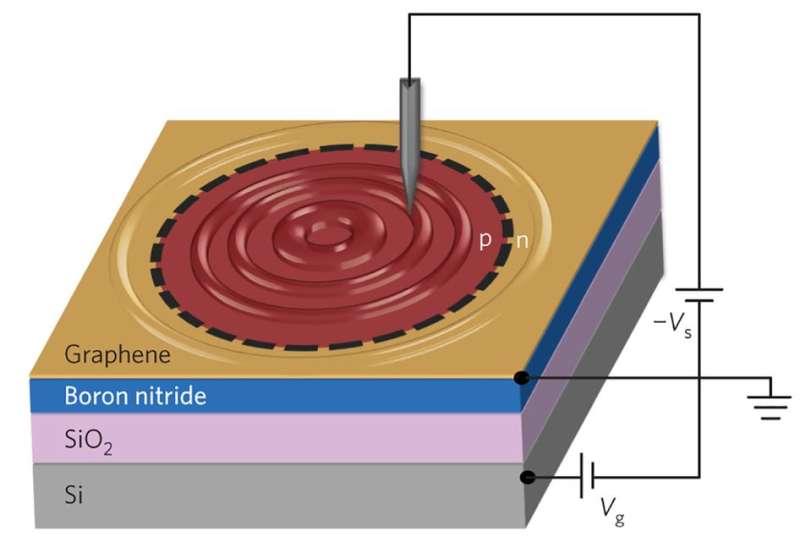July 15, 2016 report
Images made of relativistic electrons trapped in graphene quantum dots

(Phys.org)—A team of researchers with the University of California, MIT, Lawrence Berkeley National Laboratory and the National Institute for Materials Science in Japan has created images of relativistic electrons trapped in graphene quantum dots. In their paper published in the journal Nature Physics the team describes how they achieved this feat and where they plan to take their work in the future.
As the many unique properties of graphene continue to unfold, scientists seek new ways to harness and eventually make use of them. One such use might be to control electrons to allow their use in nano-scaled devices, which could also inadvertently lead to a deeper understanding of Dirac fermions. In this new effort, the researchers have made progress in that area by devising a means for capturing and holding electrons and for creating images of the result.
Obtaining images of electron waveforms has thus far been particularly difficult—virtually all existing methods have resulted in too many defects. To get around such problems, the researchers took another approach to capturing the electrons. They first created circular p-n junctions by sending voltage through the tip of a scanning tunneling microscope down to a graphene sample below. At the same time, they also applied voltage to a slab of silicon underneath the piece of graphene, which was kept separated by a layer of silicon-oxide and a flake of boron nitride. Doing so caused defects in the boron nitride to ionize, resulting in charges migrating to the graphene.
To create images of those charges, the researchers placed a scanning tunneling microscope tip just above the surface of the quantum dot, which allowed for measuring the tunneling current—moving the tip to different locations allowed for taking multiple measurements which when taken together allowed for creating an image.
The new method, the team suggests, could be used as the basis for developing systems that are more complicated, such as those with multiple quantum dots. They next plan to investigate using their technique with bilayer graphene samples, which hold far more Dirac charge carriers to see if they reflect when they impinge on the p-n junction barrier in expected ways.
More information: Juwon Lee et al. Imaging electrostatically confined Dirac fermions in graphene quantum dots, Nature Physics (2016). DOI: 10.1038/nphys3805
Abstract
Electrostatic confinement of charge carriers in graphene is governed by Klein tunnelling, a relativistic quantum process in which particle–hole transmutation leads to unusual anisotropic transmission at p–n junction boundaries. Reflection and transmission at these boundaries affect the quantum interference of electronic waves, enabling the formation of novel quasi-bound states. Here we report the use of scanning tunnelling microscopy to map the electronic structure of Dirac fermions confined in quantum dots defined by circular graphene p–n junctions. The quantum dots were fabricated using a technique involving local manipulation of defect charge within the insulating substrate beneath a graphene monolayer. Inside such graphene quantum dots we observe resonances due to quasi-bound states and directly visualize the quantum interference patterns arising from these states. Outside the quantum dots Dirac fermions exhibit Friedel oscillation-like behaviour. Bolstered by a theoretical model describing relativistic particles in a harmonic oscillator potential, our findings yield insights into the spatial behaviour of electrostatically confined Dirac fermions.
Journal information: Nature Physics
© 2016 Phys.org





















